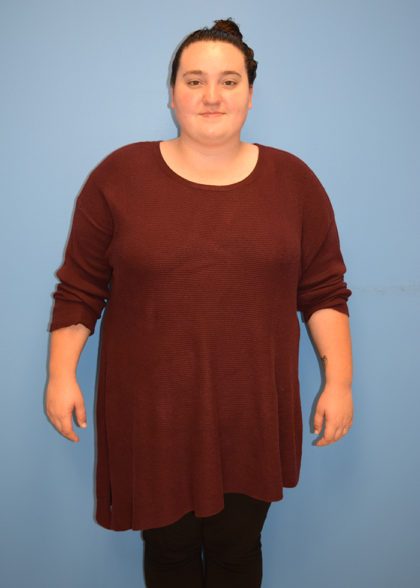Gastric Sleeve Surgery
Conveniently located to serve the areas of Houston and Katy

Gastric Sleeve Surgery, also known as Vertical Sleeve Gastrectomy (VSG), is a bariatric procedure that removes 75-80% of the stomach. (1) It is the most commonly performed weight-loss procedure in the United States and worldwide. Patients can expect an excess weight loss of about 60-70% within one year of surgery, accompanied by remission or improvement of obesity-related health conditions such as:
- Diabetes Mellitus Type II
- Hypertension
- Sleep Apnea
- Fatty Liver Disease
- Joint Pain
- Hyperlipidemia
- Infertility
Before and After Photos
Patients experience less desire to eat due to a decrease in gastric volume and a decrease in ghrelin (hunger hormone) production. In many cases, patients also experience a reduction in hunger sensation.
Providing extensive knowledge and expert surgical skills, consult with Dr. Ricardo Bonnor, MD, FACS, FASMBS to find out more about bariatric surgery, and to see if sleeve surgery is for you.
Contents
About Sleeve Surgery
Almost 99 million Americans are affected by obesity. (2) Excess weight can have detrimental effects on overall health, increasing the risk of various medical conditions such as diabetes, heart disease, and joint problems. If traditional methods of weight loss have proven ineffective, surgical intervention may be a good option.
This procedure entails reducing the stomach size by removing a portion of it. The surgeon creates a smaller sleeve-shaped stomach, which limits the amount of food one can consume,aiding calorie reduction. Consequently, this supports sustained weight loss and enhances metabolic health over the long term.
Benefits of Sleeve Surgery
Gastric sleeve surgery offers numerous benefits as a weight loss solution. Firstly, it significantly reduces the capacity of the stomach, leading to a feeling of fullness even with smaller portions of food. This helps patients consume fewer calories, promoting weight loss over time. Additionally, the procedure removes the part of the stomach responsible for producing the hunger hormone ghrelin. As a result, some patients experience reduced hunger and cravings, making it easier to adhere to a healthier diet.
This type of bariatric surgery uses minimally invasive techniques, which involve making four small incisions in the abdomen rather than a large, open incision. Through these incisions, a laparoscope and specialized instruments are used to perform the surgery. Minimally invasive techniques offer several advantages, including less postoperative pain, shorter hospital stays, quicker recovery, and smaller scars.
In addition to the above advantages, sleeve surgery avoids some of the long-term issues associated with other weight-loss surgeries, such as internal hernias and small bowel obstructions. (3)
Candidates for Sleeve Surgery
Candidates for sleeve surgery are individuals who are struggling with obesity and have not achieved satisfactory weight loss through traditional methods such as diet and exercise. A patient’s Body Mass Index (BMI) plays an important role. (4)
- Patients with a BMI of 30 or higher may be considered for VSG surgery.
- Patients with a BMI of 35 or more with at least one obesity-related condition may also be considered for VSG surgery.
This procedure is suitable for those who are committed to making long-term lifestyle changes and are willing to adopt a healthy diet and engage in regular physical activity.
Comparison of Sleeve with other Weight-Loss Surgeries
Laparoscopic gastric banding (lap-band) was once very popular. However, due to its high rate of long-term complications and inferior weight loss, the number of lap-band surgeries has decreased every year in the US and worldwide.
Dr. Bonnor does not perform the lap-band procedure at this time. Laparoscopic Roux-en-Y Gastric Bypass Surgery is the gold standard of bariatric surgery. However, the sleeve has replaced gastric bypass surgery as the most popular bariatric surgery in recent years due to its technical simplicity and fewer long-term complication rates.
Which is Better: Sleeve Surgery or Gastric Bypass?
Technically, sleeve gastrectomy is a much simpler surgery. The operating time for the sleeve surgery is usually 45 -60 minutes, while gastric bypass surgery takes approximately 2 to 3 hours to complete. There is a much lower chance of nutrient or vitamin deficiency with the sleeve procedure. In addition, there is no malabsorption for Sleeve patients as well as no bowel obstruction, marginal ulcers, or internal hernias that would otherwise occur with a gastric bypass. The chances of sleeve patients developing these complications are exceedingly rare.
Recovery
This procedure is designed to facilitate rapid recovery. In fact, some patients may be candidates for same-day discharge following surgery. On another note, one of the most crucial aspects of a successful recovery is initiating walking shortly after surgery to aid in blood circulation and assist in expelling gas from the body. By three weeks, patients are able to resume physical activity, and the diet will continue to progress accordingly. In general, the pain is easily manageable after surgery. Most patients take less than the recommended pain medication. Most patients go back to work and/or school after 1 week.
Diet After Sleeve Surgery
- Day 1 to 14: liquid diet, including protein shakes, water, Gatorade, and broth.
- Weeks 2 to 4: Puree food
- Week 4 to 12: Soft food
- Recommend patients take multivitamins and vitamin D after surgery.
Fatigue is common in the first 2 weeks due to low-calorie intake from the liquid diet. However, the majority of patients do not feel hungry during this stage of the diet. The energy level improves quickly after the introduction of the soft diet, which is approximately 2 weeks after surgery. Patients can begin exercising 3 weeks after surgery.
Post-Weight-Loss Surgery Body Contouring
As well as being an experienced bariatric surgeon, Dr. Bonnor is a board-certified cosmetic surgeon experienced in post-bariatric surgery body contouring. If unwanted, loose skin and tissue hide the results of weight loss surgery, we can work with you to smooth and shape your body and ensure you feel and look your best.
Cost of Sleeve Surgery in Houston
Schedule a consultation with one of Houston’s best bariatric surgeons at Texas Endosurgery Associates to start your life-changing sleeve procedure today.
Call (281) 579-5638 or fill out our online form for more details.
Commonly Asked Questions (FAQ)
Am I a good candidate for sleeve surgery?
Candidacy for gastric sleeve surgery is determined on an individual basis. Generally, patients with a body mass index (BMI) of 40 or higher, or a BMI of 35 or higher with significant obesity-related health conditions, may be eligible for this procedure. It is important to consult with a qualified bariatric surgeon to assess your unique situation and determine if gastric sleeve surgery is the right choice for you.
Does gastric sleeve surgery have a shorter recovery time compared to gastric bypass?
Am I a good candidate for sleeve surgery? Candidacy for gastric sleeve surgery is determined on an individual basis. Generally, patients with a body mass index (BMI) of 40 or higher, or a BMI of 35 or higher with significant obesity-related health conditions, may be eligible for this procedure. It is important to consult with a qualified bariatric surgeon to assess your unique situation and determine if gastric sleeve surgery is the right choice for you.
Does gastric sleeve surgery have a shorter recovery time compared to gastric bypass?
Is gastric sleeve recovery uncomfortable?
In the initial stages of recovery, it is normal to experience some discomfort and pain. However, your surgeon will prescribe appropriate medication to manage any discomfort and promote healing. It is important to follow all post-operative instructions provided to optimize your recovery and achieve the best possible results.
Will sleeve surgery mean I lose a lot of weight?
Gastric sleeve surgery is a powerful tool in the treatment of obesity, offering significant and sustainable weight loss results. However, patients should approach the surgery as part of a comprehensive treatment plan that includes lifestyle changes and ongoing medical support. If you are struggling with obesity and are interested in exploring your options for weight loss, it is advisable to schedule a consultation with an experienced bariatric surgeon to discuss your individual needs and goals.
References
- Karmali S, Schauer P, Birch D, Sharma AM, Sherman V. Laparoscopic sleeve gastrectomy: an innovative new tool in the battle against the obesity epidemic in Canada. Canadian journal of surgery Journal canadien de chirurgie. 2010;53(2):126-132. Accessed November 7, 2023. https://www.ncbi.nlm.nih.gov/pmc/articles/PMC2845949/
- Seeras K, Lopez PP. Sleeve Gastrectomy. Nih.gov. Published January 19, 2019. https://www.ncbi.nlm.nih.gov/books/NBK519035/
- Hoyuela C. Five-year outcomes of laparoscopic sleeve gastrectomy as a primary procedure for morbid obesity: A prospective study. World Journal of Gastrointestinal Surgery. 2017;9(4):109-117. doi:https://doi.org/10.4240/wjgs.v9.i4.109
- Stahl JM, Malhotra S. Obesity Surgery Indications And Contraindications. PubMed. Published 2020. https://www.ncbi.nlm.nih.gov/books/NBK513285/














